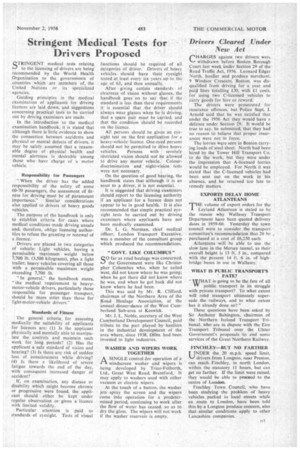Stringent Medical Tests for Drivers Proposed
Page 43

If you've noticed an error in this article please click here to report it so we can fix it.
STRINGENT medical tests relating to the licensing of drivers are being recommended by the World Health Organization to the governments of countries which are members of, the United Nations or its specialized agencies.
Guiding principles in the medical examination of applicants for driving licences are laid down, and suggestions concerning practical tests to be carried out by driving examiners are made.
In the introduction to the medical examination handbook, it is stated that although there is little evidence to show the connection between accidents and physical or mental defects of drivers, it may be safely assumed that a reasonable degree of physical health and mental alertness is desirable among those who have charge of a motor vehicle.
Responsibility for Passengers " When the driver has the added responsibility of the safety of some 60-70 passengers, the assessment of fitness for driving must be of paramonnt importance." Similar considerations also applied to drivers of heavy goods vehicles.
The purpose of the handbook is only to establish criteria for cases where medical conditions made driving unsafe and, therefore, oblige licensing authorities to refuse the granting or renewal of a licence.
Drivers are placed in two categories of vehicle: Light vehicles, having a permissible maximum weight below 7,700 lb. (3,500 kilograms), plus a light trailer; heavy vehicles covering all those with a permissible maximum weight exceeding 7,700 lb.
" In general." the handbook states, "the medical requirement in heavymotor-vehicle drivers, particularly those responsible for passenger transport, should be more strict than those for light-motor-vehicle drivers."
Standards or Fitness
The general criteria_ for assessing medically the suitability of applicants for licences are: (1) Is the applicant physically and mentally able to manipulate the controls and maintain such work for long periods? (2) Has the applicant a safe standard of vision and hearing? (3) Is there any risk of sudden loss of consciousness while driving? (4) Is there a likelihood of severe fatigue towards the end of the day, with consequent increased danger of accident?
If, on examination, any disease or disability which might become chronic or progressive were found, the applicant should either be kept under regular observation orgiven a licence with limited validity.
Particular attention is paid to standards of eyesight. Tests of visual functions should be required of all categories of driver. Drivers of heavy vehiclesshould have their eyesight tested at least every six years up to the age of 65, and then annually.
After giving certain standards of clearness of vision without glasses, the handbook goes on to say that if the standard is less than these requirements it is essential that the driver should always wear glasses when he is driving, that a spare pair must be carried, and that the condition should be recorded on the licence.
All persons should be given an eyesight test on the first application for a heavy-vehicle licence. One-eyed persons should not be permitted to drive heavy vehicles. Persons with severely restricted vision should not be allowed to drive any motor vehicle. Colourdiscrimination and • night-vision tests were not necessary.
On the question of good hearing, the handbook states that although it is an asset to a driver, it is not essential.
It is sUggested that driving examiners should report to the licensing authority if an applicant for a licence does not appear to be in good health. It is also recommended that simple practical eyesight tests be carried out by driving examiners where applicants have not been medically examined.
Dr. L. G. Norman, chief medical officer. London Transport Executive. was a member of the consultant group which produced the recommendations.
"GOVT. LIKE COLUMBUS"
S0 far as road haulage was concerned, the Government were like Christopher Columbus who, when he sailed west, did not know where he was going; when he got there did not know where he was, and when he got back did not know where he had been.
This was said by Mr.. R. Clifford, chairman of the Northern Area of the goad Haulage Association, at the annual dinner-dance of the West Cum berland Sub-area at Keswick. •
Mr. 1. L. Noble, secretary of the West Cumberland Development Council, paid tribute to the part played1 by hauliers in the industrial development of the area where, since 1938, £80m. had been invested in light industries.
WASHER AND WIPERS WORK TOGETHER
A SINGLE control for operation of a In windscreen washer and wipers is being developed by Trico-Folberth, Ltd., Great West Road, Brentford, It may apply to washers used with either vacuum or electric wipers.
At the touch of a button, the washer jets spray the screen and the wipers come into operation for a predetermined period, continuing to work after the flow of water has ceased, so as to dry the glass. The wipers will not work if the washer reservoir is empty.
















































































































